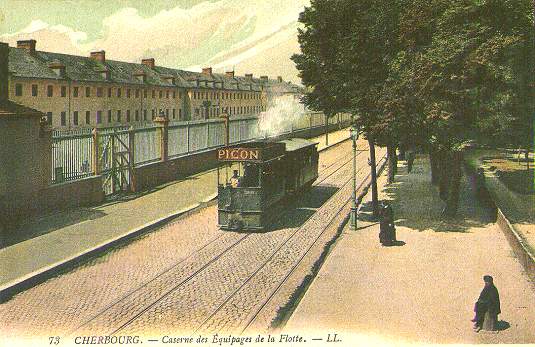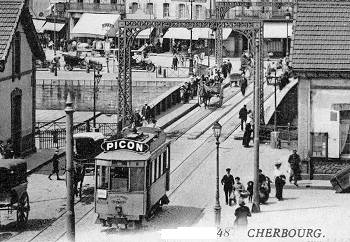

Cherbourg is an important French naval port. Our postcard, showing a steam tram, is titled "Caserne des équipages de la flotte" which translates as "barracks of the crews of the fleet". The card is number 73 in the Cherbourg series from French card publishers, Lévy Fils et Cie, of 44 Rue Letellier, Paris, and was produced about 1905. The small view below is an extract from Lévy card 48, and shows a new electric car in 1910 about to cross the "pont tournant", the swing bridge, across the entrance of the town's basin.
After two false starts with concessions, one of which was to an English company, in 1896 a concession was granted to a Monsieur Laval which was soon transferred to the Compagnie des Tramways de Cherbourg who built the initial routes, the first opening to traffic on 22nd May 1897. Steam traction was used and the track was to metre gauge. The network joined Cherbourg with the surrounding districts of Equeurdreville, Querqueville and Tourlaville, with a 5.5km urban section (Château-Gare-Octroi) and a 1919 extension to Urville, bringing the total network size to 16.5km. The depot was at Tourlaville.
The Swiss steam trams used were built by Schweizerische Locomotiv und Maschinenfabrik of Winterthur. Two were 0-6-0s weighing 13.5 tons and five were 0-4-0s weighing 10.5 tons. There was an additional 0-6-0 acquired second hand from Geneva. There were also three French Serpollet boilered self-contained steam tramcars built by Ateliers de Construction du Nord de la France at Blanc Misseron. There were 8 bogie trailers seating 54, 3 smaller trailers seating 46 and four open trailers seating 44.
 In 1910 the urban section was electrified using 15 4-wheel trams built by Decauville, with steam continuing on the country lines. In 1914 the steam services were suspended for the duration of the Great War. After the war full electrification was proposed, and this took place from 10th July 1920. Due to decline in traffic and financial problems, in 1937 control of the network passed to the local authority. Services were badly disrupted by the German invasion during the Second World War. The depot, rolling stock and the swing bridge were destroyed by bombardment at the time of the allied landings in 1944, causing the tramway to be abandoned.
In 1910 the urban section was electrified using 15 4-wheel trams built by Decauville, with steam continuing on the country lines. In 1914 the steam services were suspended for the duration of the Great War. After the war full electrification was proposed, and this took place from 10th July 1920. Due to decline in traffic and financial problems, in 1937 control of the network passed to the local authority. Services were badly disrupted by the German invasion during the Second World War. The depot, rolling stock and the swing bridge were destroyed by bombardment at the time of the allied landings in 1944, causing the tramway to be abandoned.
![]() Go to Postcard Of The Month Index
Go to Postcard Of The Month Index